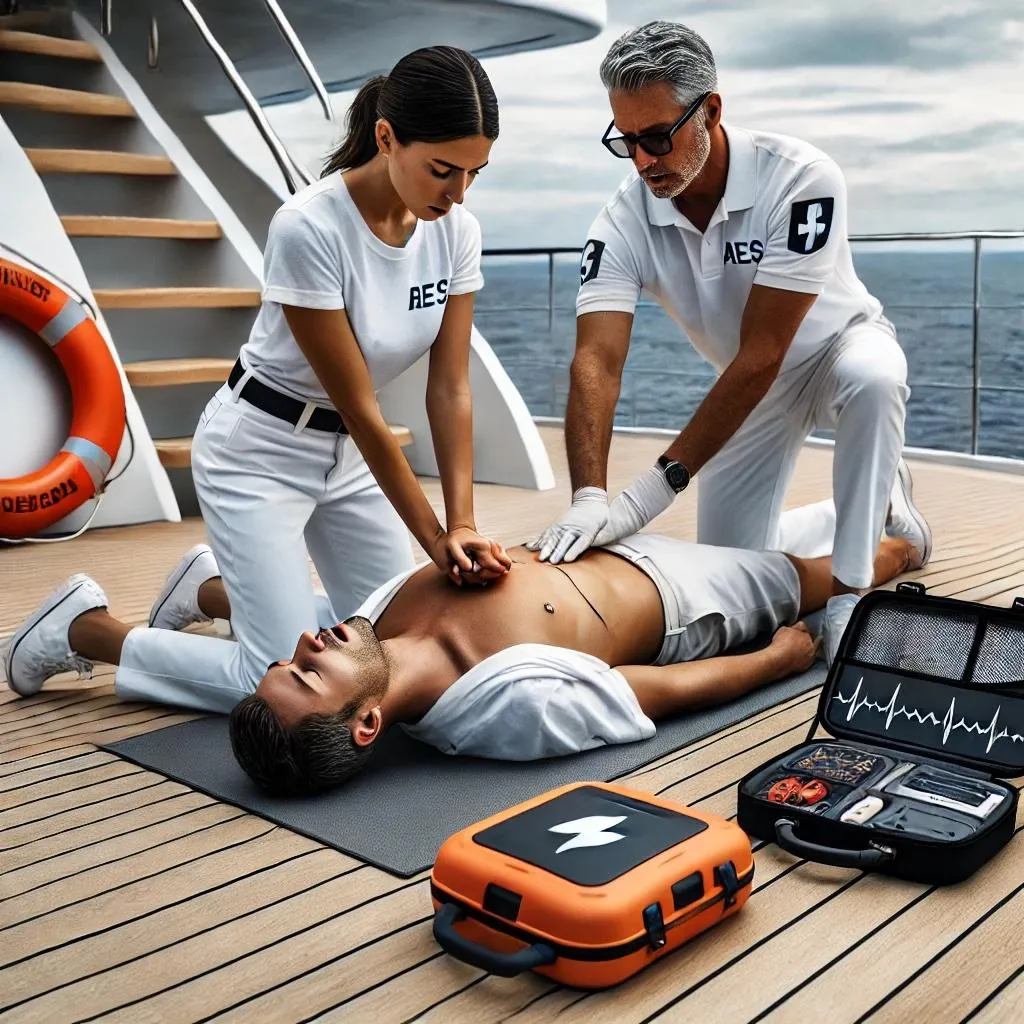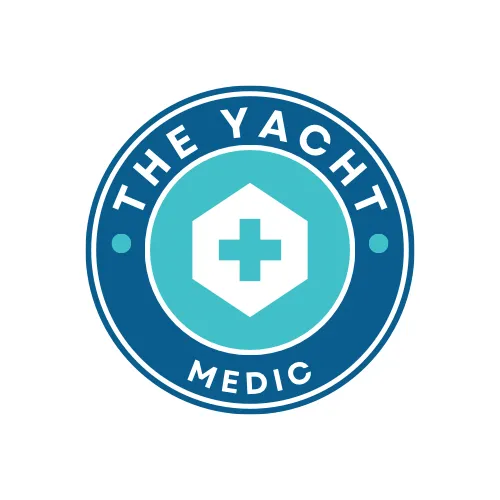See Our Latest Blogs
Beyond Boundaries, Beyond Rescue
Mastering Self Reliance At Sea

CPR onboard a Superyacht
Performing CPR on a Guest at Sea – When the Yacht Becomes the Hospital
We’re anchored off Green Island, Antigua. A guest suffers a suspected heart attack. Despite the crew’s best efforts, his breathing deteriorates… and then stops.
No pulse. No breathing. Cardiac Arrest.
There’s no hospital. No ambulance. No paramedics.
The yacht is now the hospital—and the crew is the medical team.
Why High-Performance CPR Matters at Sea:
Unlike on land, where emergency medical services arrive within minutes, at sea there is no backup.
Your crew must sustain high-quality CPR for as long as it takes—sometimes 20, 30, even 40 minutes until medevac or telemedicine support can take over.
On a yacht, your team is the frontline medical response. Your ability to deliver effective compressions, minimize hands-off time, and use the AED correctly is often the difference between life and death.
The Emergency Response – What Happens Next?
Because they’ve trained, the crew responds fast and professionally—following their Emergency Management Plan (EMP):
✔ Scene cleared, guests moved away
✔ AED ready, pads exposed
✔ Roles assigned: Medical Lead, CPR Lead/Second, Airway & Oxygen, Defibrillator, Logistics/Timekeeper, Scribe
Step 1: Confirm Cardiac Arrest
• Unresponsive—no reaction to voice or pain
• No breathing or only agonal gasps
• No pulse
Decision made—start CPR immediately.
If they’re not breathing, you perform CPR.
Step 2: High-Quality CPR Starts Immediately
• 30 chest compressions—hard, fast, center of the chest
• Depth: 5-6 cm | Rate: 100-120 per minute
• 2 rescue breaths (if safe and trained) or hands-only CPR
• Use a bag-valve mask if trained and available
• Apply oxygen if possible
Why: High-quality CPR keeps oxygen flowing to the brain and vital organs until the heart restarts.
Step 3: Apply the AED Immediately
• Pads on bare chest—dry the skin, remove excess moisture
• Follow AED voice prompts
• If advised—stand clear, deliver shock
• Immediately resume CPR after shock
Note:
Modern AED pads are designed to adhere well, even with moderate chest hair. Shave only if poor contact prevents effective shock.
Step 4: Continue CPR Cycles and Monitor
✔ 30 compressions to 2 breaths
✔ Reassess AED prompts every 2 minutes
✔ Rotate compressors every 2 minutes—CPR is exhausting
✔ Continue until:
• Return of spontaneous circulation (ROSC)
• Telemedicine or medevac team advises stopping
• Crew physically unable to continue
Step 5: Real-Time Communication with Telemedicine
• Maintain contact with MSOS / THEMIS / Telemedicine
• Report vitals, CPR quality, AED shocks
• Prepare for helicopter medevac or tender transfer
• Document all actions and time-stamp every event
Psychological Reality Check:
CPR is physically and emotionally demanding. Crew fatigue, adrenaline, and emotion hit hard.
✔ Rotate compressors every 2 minutes
✔ Assign someone to monitor the team’s mental load
Debriefing and psychological support will be essential after the incident.
Final Thought:
In that moment—the yacht is the hospital.
Your training, preparation, and calm, structured response are what give that guest a fighting chance.
You can’t wait for help. You are the help.
Next in the Series:
What happens if the casualty cannot be revived?
Handling death onboard, protecting the scene, and supporting the family and crew.
Disclaimer:
This content is for educational purposes only and is not medical advice. It is not a substitute for certified CPR training or professional medical guidance.
Always follow your yacht’s medical protocols and consult your telemedicine provider. Ensure your crew is trained and certified in CPR and AED use by a recognized authority.
In a real emergency, immediate action and professional support are critical.
P.S. This image was AI-generated—no real guests or crew were used, in the image or the story.
1.European Resuscitation Council (ERC) Guidelines 2021
ERC Guidelines for Adult Basic Life Support and Use of Automated External Defibrillators (AEDs)
2.American Heart Association (AHA) Guidelines for CPR and ECC 2020
3.International Maritime Organization (IMO) Medical First Aid Guide for Use in Accidents Involving Dangerous Goods (MFAG)
4.Maritime and Coastguard Agency (MCA) MSN 1905(M) - The Medical Stores Regulations
UK MCA requirements for ship medical kits including aspirin and AEDs
5.UK Resuscitation Council – AED Use Guidance
https://www.resus.org.uk/library/2021-resuscitation-guidelines/automated-external-defibrillation-aed
6.Marine Medical Guide: The Ship Captain’s Medical Guide (22nd Edition)
UK Department for Transport – Comprehensive medical guidance for ships
https://www.gov.uk/government/publications/the-ship-captains-medical-guide
7.US Coast Guard Medical Manual COMDTINST M6000.1F
USCG guidance for medical care onboard vessels, including CPR and AED requirements
8.International Maritime Health Association (IMHA) Recommendations on Telemedicine and Emergency Medical Response at Sea
9.MSOS THEMIS Telemedicine Platform – Superyacht Medical Support Guidelines
10.World Extreme Medicine (WEM) – Maritime and Expedition Medical Training Principles
https://worldextrememedicine.com
Sail Safely with Expert Medical Training
Resilience & Psychological First Aid For Yachts

Resilience First Aid (RFA) is a proactive approach to mental health, designed to equip yacht crew with the skills to prevent burnout, manage stress, and strengthen mental resilience.
Psychological First Aid (PFA) is an
immediate, compassionate response to mental distress after a crisis,
support each other emotionally, reduce trauma impact, and promote recovery
after major incidents.
Medical First Aid & Planning for Yachts

This course is designed to equip yacht owners & crew with essential first aid skills and the knowledge to set up a well-stocked and effective medical kit. Whether you're preparing for remote cruising or need to update your onboard medical resources, this course ensures you’re ready for any medical emergency.
Yachts operate in remote locations, often far from immediate medical help.
Adventure Preparation for Remote Environments

When you venture into remote environments preparation is everything. The Adventure Ready Program equips leaders, yacht crew, expedition teams, and outdoor professionals with the medical skills, resilience training, and leadership strategies
needed to handle emergencies, adapt under pressure, and thrive in extreme environments.
Be Prepared, Stay Safe & Protect Your Crew
© The Yacht Medic - All Rights Reserved,
Photography & Media by Oli Riley Photography

info@the-yacht-medic.com
+34610120242
Palam de Mallorca, Spain
